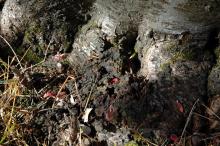See:
Cherry (Prunus spp.) - Crown Gall
Cause The bacterium Agrobacterium tumefaciens has a wide host range including all Prunus spp. as well as apple, euonymus, poplar, rose, walnut, and willow. The bacteria can live for several years in the soil, often spreading from diseased nursery stock. It can also be moved by irrigation water and cultivation equipment. The bacterium enters plants through wounds, either natural or caused by pruning, grafting, mechanical injury from cultivation, heaving of frozen soils, chewing insects, or the emergence of lateral roots. After the bacterium enters a wound, a small piece of its DNA is transferred into the plant's DNA. The foreign DNA transforms normal plant cells in the wounded area into tumor cells. Once transformed, tumor cells proliferate automatically.
Symptoms On young nursery trees, soft, spongy, or wart-like galls develop on the roots or root crown. Galls on mature trees range from a fraction of an inch to several inches across. Galls on woody plants become hard and develop a rough, fissured surface as they age. Gall tissues are irregular and have no definite growth pattern. Young trees may die if their trunks are completely encircled by galls. Symptoms may not develop for over a year if infection occurs when temperatures are below 59° F (15°C).
Cultural control
- Plant only disease-free nursery stock after inspecting new trees to avoid planting any with gall symptoms.
- Do not plant nursery trees in soil with a recent history of crown gall.
- Preplant soil solarization has been effective for nursery stock in western Oregon. Place clear plastic (preferably anti-condensation film) directly on smooth, rototilled ground, which has been irrigated to field capacity and then allowed to drain for 1-2 days. Bury the edges of the plastic to trap the heat. Solarize for 4 to 6 weeks (or longer) during the hottest part of the summer, beginning in early- to mid-July.
- Use care in planting trees, avoiding injury to bark around the root crown, because bacteria in the soil can enter the injured tissue.
- Plant in well-drained soils, when the soil temperature is below 50°F (10°C).
Biological control Agrobacterium radiobacter strain 84 is preventive only. Latent infections (symptomless) and existing galls will not be controlled. A suspension of strain 84 may be used as a soak or spray. Thoroughly cover grafting wood, roots, and crown. Spray to runoff. To be effective it must be applied a few hours after wounding.
- Galltrol-A (Agrobacterium radiobacter K84). Not registered in Idaho. 12-hr reentry. O
- NOGALL at 8.8 oz/2.5 gal unchlorinated water per 2,500 nonbearing plants. Apply within 2 hours of lifting and/or damaging plants. Do not use with any pesticides or fertilizers. 4-hr reentry. O
Reference Pscheidt, J.W., and Byther, R.S. 2001. Prunus Diseases p 317-325 in Diseases of Woody Ornamentals and Trees in Nurseries, R. Jones., and M. Benson (ed.). St. Paul, MN: APS Press.




